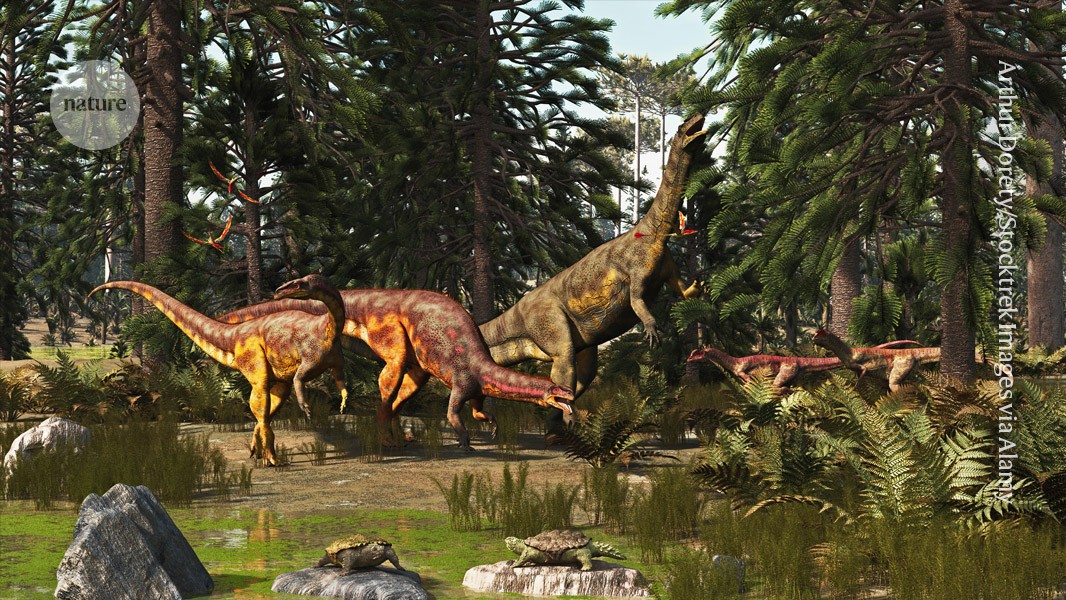Fossilized poo and vomit shows how dinosaurs rose to rule Earth

Analysis of 200-million-year-old digested foods reveals how the animals became dominant

Dinosaurs rose to prominence over millions of years.Credit: Arthur Dorety/Stocktrek Images via Alamy
Faeces and vomit fossils from dinosaurs reveal how evolved dinosaurs to rule Earth. The study, which was published in Nature on 27 November, analysed hundreds of pieces of fossilized digestive material, called bromalites, to reconstruct what dinosaurs ate and how this changed1. The fossils reveal that the rise of the dinosaurs, over millions of years during the Triassic period, was influenced by factors including climate change and other species’ extinction.
“Our study shows that you can use pretty seemingly unremarkable fossils to get pretty remarkable results,” says co-author Martin Qvarnström, who studies early dinosaur evolution at Uppsala University in Sweden.
Palaeontologists have come up with differing theories for how dinosaurs became the dominant species on Earth. For example, dinosaurs might have overtaken their rivals because they were particularly able to adapt to a changing ecosystem, for instance, or because random environmental changes favoured them over other species. But there isn’t a single hypothesis that fully explains their rise to dominance.

Fossilized faeces samples revealed dinosaurs’ changing diets.Credit: Grzegorz Niedzwiedzki
What dinosaurs ate
To better understand dinosaurs’ early evolution, Qvarnström and his colleagues cut open and examined more than 500 bromalites from the Polish Basin in Central Europe. The fossils are estimated to be around 200 million years old.
The team used several methods to analyse the bromalites and their contents, including different types of microscope and a technique known as synchrotron microtomography, which uses a particle accelerator to see inside the fossils in detail. The researchers also used chemical solutions to inspect the exact contents of the remains, which included fish, plants and insects.
Despite the age and acidity of many of the fossils, the team found many of the insects the dinosaurs ate to be well preserved. “Some of them were so beautifully preserved in three dimensions and with all the antennae and legs,” says Qvarnström.
Analysis of the digestive materials allowed the researchers to “reconstruct these food webs, so who was eating whom in all these assemblages and see this trend over such a long period of time”, Qvarnström says.
Adapt or die
The team found that the number and variety of the contents of the fossils increased over time, suggesting that larger dinosaurs with more diverse feeding habits began to gain prominence in the late Triassic period (between 237 million and 201 million years ago). By comparing the fossils with plant data from the period, the researchers found that dinosaurs’ rise was shaped by chance and by adaptations. For example, climate change led to increased humidity, which changed the vegetation available. Dinosaurs were able to better adapt to this shifting climate and change in diet than other land animals.

Team members conduct excavations in Lisowice, Poland, at a site from the Late Triassic.Credit: Krystian Balanda
“What we learnt was that the rise of dinosaurs, it took quite a long time, and it was really complex,” says Qvarnström.
This is “an impressive piece of work”, says Suresh Singh, who studies palaeoecological dynamics at the University of Bristol, UK. He adds that this is the first time he’s seen bromalite-focused research applied at such scale.
Singh says dinosaurs are an important source of data for understanding of how life responds to different pressures, for example climate change.
He suggests that future research could use bromalites to understand how dinosaurs evolved in different parts of the world. “Current studies suggest that dinosaurs evolved first in the Southern Hemisphere, and so maybe you have a different pattern happening down there,” he says.
doi: https://doi.org/10.1038/d41586-024-03889-y
Read the related News & Views ‘Faeces and vomit record the rise of dinosaurs’.
This story originally appeared on: Nature - Author:Helena Kudiabor


















